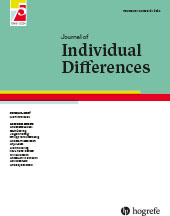Abstract
Zusammenfassung: Vorgestellt wird ein Instrument zur Verhaltensbeobachtung in dyadischen Interaktionssituationen, die deutsche Form des Riverside Behavioral Q-Sort (RBQ; Funder, Furr & Colvin, 2000). Es zeigte sich, dass die Items des RBQ-D (Spinath, Spinath & Funder, 2000) insgesamt akzeptable Reliabilitäten aufwiesen und geeignet waren, interindividuelle Differenzen im Verhalten von N = 88 Zielpersonen in einer Gesprächssituation abzubilden. Belege für die Validität des Verfahrens wurden im Rahmen eines multimethodalen Ansatzes gesammelt: Es ergaben sich erwartungsgemäße Zusammenhänge zwischen den Items des RBQ-D und Selbst-, Bekannten- und Fremdeinschätzungen der Dimensionen des Fünf-Faktoren-Modells der Persönlichkeit (Costa & McCrae, 1992). Die Stärke der gefundenen Zusammenhänge entspricht dabei derjenigen aus anderen Studien zur Einschätzung von Persönlichkeitsmerkmalen bei minimaler Information. Mit Hilfe einer zusätzlichen Stichprobe (N = 46) konnten darüber hinaus erwartungskonforme Zusammenhänge zwischen RBQ-D-Maßen von eineiigen Zwillingen nachgewiesen werden. Insgesamt erscheint uns der RBQ-D ein brauchbares Instrument zur Erhebung sozialer Verhaltensweisen, das durch weitere Forschungsbemühungen noch weiter zu optimieren ist.
Abstract: We present the German version of the Riverside Behavioral Q-Sort (RBQ; Funder, Furr & Colvin, 2000), an instrument for behavioral observations in dyadic interactions. Compared to the original RBQ, the German RBQ-D (Spinath, Spinath & Funder, 2000) yielded slightly lower, yet acceptable reliabilities, and most of its items discriminated between N = 88 target individuals in a communication situation. Evidence for the validity of the RBQ-D was gathered within a multi-method approach: RBQ-D-items yielded theoretically meaningful correlations with self-, peer- and stranger-ratings on the dimensions of the Five-Factor-Model of personality (Costa & McCrae, 1992). The magnitude of these associations was comparable to findings from other personality-rating studies based on minimal information. Moreover, within an additional sample of monozygotic twins (N = 46) RBQ-D measures yielded substantial intra-pair correlations. We conclude that the RBQ-D is a valuable tool for the assessment of behavioral data in social situations that deserves further efforts for its improvement.
References
Blackman, M.C. , Funder, D.C. (1998). The effect of information on consensus and accuracy in personality judgment.. Journal of Experimental Social Psychology, 34, 164– 181 .Block, J. (1978). The Q-sort method in personality assessment and psychiatric research. . Palo Alto, CA: Consulting Psychologists Press. .Borkenau, P. , Liebler, A. (1992). Trait inferences: Sources of validity at zero acquaintance.. Journal of Personality and Social Psychology, 62, 645– 657 .Borkenau, P. , Liebler, A. (1993). Convergence of stranger ratings of personality and intelligence with self-ratings, partner ratings, and measured intelligence.. Journal of Personality and Social Psychology, 63, 446– 553 .Borkenau, P. , Ostendorf, F. (1993). NEO-5-Faktoren-Inventar (NEO-FFI). . Göttingen: Hogrefe. .Costa, P.T., Jr. , McCrae, R.R. (1992). Revised NEO Personality Inventory and NEO Five Factor Inventory Professional Manual. . Odessa, FL: Psychological Assessment Resources. .Eaton, L.G. , Funder, D.C. (2003). The creation and consequences of the social world: An interactional analysis of extraversion.. European Journal of Personality, 17, 375– 395 .Funder, D.C. , Furr, R.M. , Colvin, C.R. (2000). The Riverside Behavioral Q-Sort: A tool for the description of social behavior.. Journal of Personality, 68, 451– 490 .Mischel, W. (1976). Introduction to personality. . New York: Harcourt Brace. .Plomin, R. , Spinath, F.M. (2004). Intelligence: Genetics, genes, and genomics.. Journal of Personality and Social Psychology, 86, 112– 129 .Shrout, P.E. , Fleiss, J.L. (1979). Intraclass correlations: Uses in assessing rater reliability.. Psychological Bulletin, 86, 420– 428 .Spinath, B. , Spinath, F.M. , Funder, D.C. (2000). Die deutsche Form des Riverside Behavioral Q-Sort (RBQ-D): Ein Instrument zur Beschreibung von Verhalten in sozialen Interaktionssituationen. . Unveröffentlichtes Testmaterial, Universität Bielefeld. .Spinath, F.M. (2000). Validität von Fremd-Beurteilungen: Einflussfaktoren auf die Konvergenz von Selbst- und Fremdbeurteilungen in Persönlichkeitseinschätzungen. . Lengerich: Pabst. .Spinath, F.M. , Riemann, R. , Hempel, S. , Schlangen, B. , Weiß, R. , Borkenau, P. , Angleitner, A. (1999). A day in the life: Description of the German Observational Study on Adult Twins (GOSAT) assessing twin similarity in controlled laboratory settings.. In I. Mervielde, I. Deary, F. De Fruyt & F. Ostendorf (Eds.), Personality psychology in Europe (pp.311-328). Tilburg, The Netherlands: Tilburg University Press. .Stephenson, W. (1953). The study of behavior: Q-technique and its methodology. . Chicago: University of Chicago Press. .



